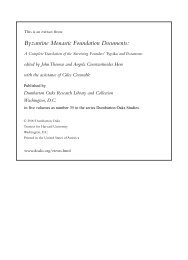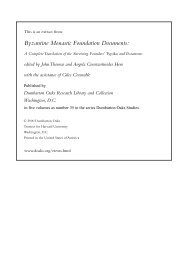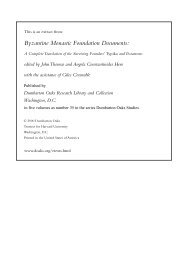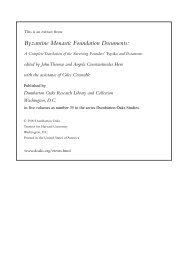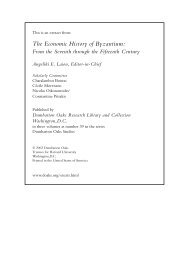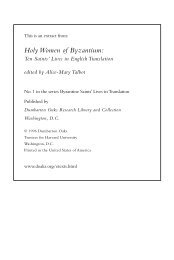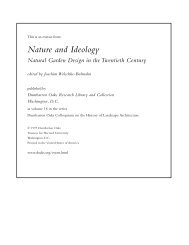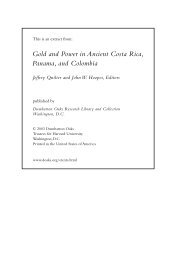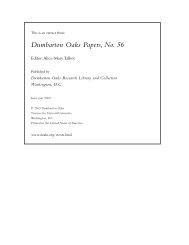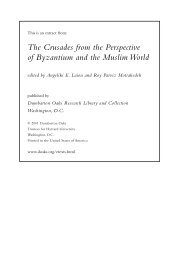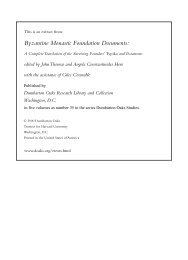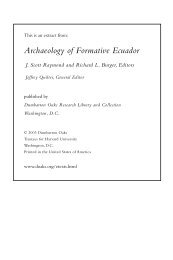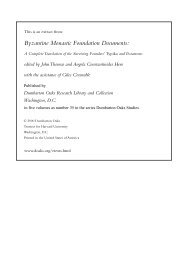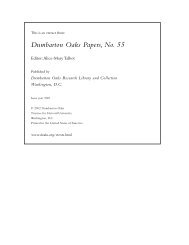Download: Mosaics of Hagia Sophia, Istanbul - Dumbarton Oaks
Download: Mosaics of Hagia Sophia, Istanbul - Dumbarton Oaks
Download: Mosaics of Hagia Sophia, Istanbul - Dumbarton Oaks
You also want an ePaper? Increase the reach of your titles
YUMPU automatically turns print PDFs into web optimized ePapers that Google loves.
The first step in making copies was the production <strong>of</strong> tracings; most <strong>of</strong><br />
them were made by N. Kluge, but R. Gregory, Adli Bay, and A. A. Green also<br />
produced some <strong>of</strong> them. The method was simple. Tracing paper was attached to a<br />
section <strong>of</strong> the mosaic panel and an assistant copied each tessera in pencil (Figs. 68,<br />
69; Pls. 1, 2). Thus, the tracings render the exact size and shape <strong>of</strong> every tessera<br />
and, therefore, the precise scale and design <strong>of</strong> the panels. The tracings were then<br />
sent to the Massachusetts Institute <strong>of</strong> Technology to be photographed. Blueprints<br />
backed on linen were produced and sent back to <strong>Istanbul</strong>. The blueprints were<br />
then painted with egg tempera, most <strong>of</strong> which was done by A. A. Green. Tracings<br />
<strong>of</strong> the Deesis panel (Fig. 58) were made by both Kluge and Green, and the painting<br />
was done by Green. The Deesis copy was exhibited at the Metropolitan Museum<br />
in 1944 and is still on permanent display there. The institute produced one copy <strong>of</strong><br />
the panels <strong>of</strong> Constantine IX and Zoe, St. Ignatios Theophoros, St. Ignatios the<br />
Younger (each <strong>of</strong> the panels is in three sections) (Pls. 3-5), and the emperor before<br />
Christ enthroned. 61 The first three <strong>of</strong> these copies were restored by <strong>Dumbarton</strong><br />
<strong>Oaks</strong> in 1997. Unfortunately, the location <strong>of</strong> the emperor before Christ enthroned<br />
has not yet been determined.<br />
The method <strong>of</strong> producing casts was developed in 1937-38 at the Fogg Art<br />
Museum, initiated by Whittemore and the director <strong>of</strong> the museum, Edward W.<br />
Forbes. 62 The hand-painted casts were made by G. Holt (Figs. 70, 71). The idea<br />
was to reproduce the vibrant surfaces <strong>of</strong> the mosaics and the texture <strong>of</strong> the tesserae.<br />
A mold, or squeeze, was made by applying a cellucotton pad to a moistened mosaic<br />
surface. Once removed, the pad was covered with shellac. When dried, this new<br />
mold was covered with a thin film <strong>of</strong> oil, and a plaster cast containing reinforcing<br />
fabric was made from it. After drying, the cast was painted. The Metropolitan<br />
Museum purchased several <strong>of</strong> the casts, including the Virgin and archangel in the<br />
Department <strong>of</strong> the Metropolitan Museum. See also Ch. R. Morey, The <strong>Mosaics</strong> <strong>of</strong> <strong>Hagia</strong> <strong>Sophia</strong>,<br />
Metropolitan Museum <strong>of</strong> Art Bulletin (New York, 1944), 201-10.<br />
61 The panel <strong>of</strong> St. Ignatios Theophoros (Pl. 4) was acquired in 1947 by <strong>Dumbarton</strong> <strong>Oaks</strong> from<br />
the Byzantine Institute, and St. Ignatios the Younger (Pl. 5) was acquired in 1950. Constantine<br />
IX and Zoe with Christ enthroned was probably acquired around this time also (Pl. 3). According<br />
to the dossier, St. Ignatios Theophoros was exhibited at the Baltimore Museum <strong>of</strong> Art in<br />
1947 in Early Christian and Byzantine Art. All three pieces were lent to the Dallas Museum <strong>of</strong> Fine<br />
Arts for the exhibition The Arts <strong>of</strong> Man, 6 August 1962-18 January 1963.<br />
62 Holt, “A Casting Method <strong>of</strong> Reproducing <strong>Mosaics</strong>,” 177-79.<br />
66




